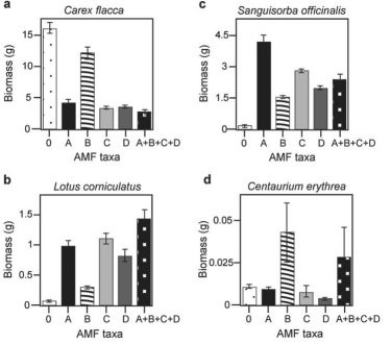Use the following information to answer the question.
Suzanne Simard and colleagues knew that the same mycorrhizal fungal species could colonize multiple types of trees. They wondered if the same fungal individual would colonize different trees, forming an underground network that potentially could transport carbon and nutrients from one tree to another (S. Simard et al. 1997. Net transfer of carbon between mycorrhizal tree species in the field. Nature 388:579-82) .
Pots containing seedlings of three different tree species were set up and grown under natural conditions for three years (Fig.A) . Two of the three species (Douglas fir, birch) could form ectomycorrhizal connections with the same fungal species, but the third species (cedar) could not form an ectomycorrhizal connection with the fungal species. In some of the pots, the researchers placed airtight bags over the Douglas fir and birch seedlings and injected carbon dioxide made from carbon-13 into the bags with the Douglas fir and carbon dioxide made from carbon-14 into the bags with the birch. (¹³C and ¹⁴C are different isotopes of carbon that can be detected and measured by researchers.) As the seedlings photosynthesized, the carbon dioxide was converted into sugars that could be tracked and measured by the researchers. The researchers measured whether the sugars in each plant contained only the carbon isotope that was in the air of their plastic bag or also the carbon isotope from the air around the other plant.
Simard et al. (1997) further hypothesized that if reciprocal transfer did occur, it would be a source-sink relationship driven by photosynthetic rates. That is, if one seedling is in full sun and the other in deep shade, there will be a net movement of carbon from the seedling in full sun to the one in deep shade. If a shade were placed over the birch seedlings and the cedar, and the Douglas fir was left in full sun, what result could Simard and colleagues expect?
Definitions:
Savant Syndrome
A condition where an individual demonstrates profound and prodigious capacities or abilities far in excess of what would be considered normal, often alongside a developmental condition such as autism.
Autism
A neurodevelopmental disorder characterized by challenges with social interaction, communication, and by restricted and repetitive behavior.
Emotional Intelligence
The capacity to identify, comprehend, control, and logically deal with one's own feelings and the feelings of others.
Empathy
Empathy is the ability to understand and share the feelings of another, fostering a sense of connection and compassion.
Q3: Soil pH is an important factor that
Q7: Canadian and Swiss researchers wanted to know
Q10: Which of the following is a major
Q23: Suppose a flower had normal expression of
Q24: Which of the following cell types retains
Q38: When a scientist describes the "body plan"
Q40: Arrange the following five events in an
Q52: You are hiking in a forest and
Q58: The legless condition that is observed in
Q79: Ancient fossils that seem to be an